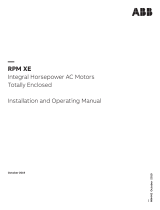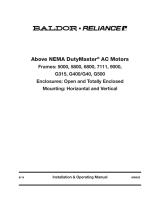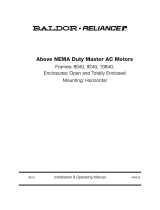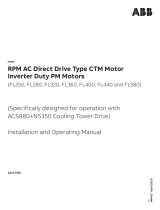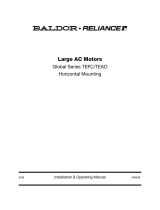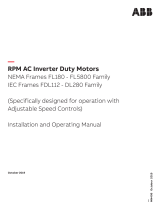Page is loading ...

1
WARNING: To ensure that drive is not unexpectedly started,
turn off and lock out or tag power source before proceeding.
Failure to observe these precautions may result in bodily
injury.
NON-EXPANSION BEARING
1. Clean shaft and bore of bearing. The shaft should be
straight, free of burrs and nicks, and correct size (see
Table 1). If used shafting is utilized, the bearing should be
mounted on unworn section.
Table 1 - Recommended Shaft Tolerance
Nominal Shaft Size Low to Normal Equivalent Loads
and Catalog Speed
Up to 1-½ Inches +.000 Inches -.0005 Inches
Over 1-1/2 to 2-1/2 Inches +.000 Inches -.0.001 Inches
Over 2-1/2 to 4 Inches +.000 Inches -.001 Inches
40–90 mm +.000 mm -.025 mm
2. Lubricate shaft and bearing bore with light oil to facilitate
assembly. Slip bearing into position. When light press t
is required, press against the end of the inner ring. Do not
strike or exert pressure on the housing or seals.
3. Mount bearing to support, using shims where necessary
to align bearing so inner ring does not rub on seal metal
shield. Use full shims which extend across the entire
housing base.
4. Determine nal shaft position and tighten setscrews in
locking collar of non-expansion bearing to recommended
torque from Table 2 while the other bearing remains free.
For normal thrust loads, shock loads, or vibration, the shaft
should be spot milled to provide additional holding power.
Under heavy thrust load applications it is advisable to use
auxiliary thrust carrying devices such as shaft shoulder,
snap rings or a thrust collar.
5. Tighten housing bolts to torque listed in Table 5.
WARNING Because of the possible danger to persons(s) or
property from accidents which may result from the improper
use of products, it is important that correct procedures be
followed: Products must be used in accordance with the
engineering information specified in the catalog. Proper
installation, maintenance and operation procedures must be
observed. The instructions in the instruction manuals must
be followed. Inspections should be made as necessary to
assure safe operation under prevailing conditions. Proper
guards and other suitable safety devices or procedures as
may be desirable or as may be specified in safety codes
should be provided, and are neither provided by Baldor
Electric Company nor are the responsibility of Baldor Electric
Company. This unit and its associated equipment must be
installed, adjusted and maintained by qualified personnel
who are familiar with the construction and operation of all
equipment in the system and the potential hazards involved.
When risk to persons or property may be involved, a holding
device must be an integral part of the driven equipment
beyond the speed reducer output shaft.
Instruction Manual DODGE
®
UNISPHERE II
Spherical Roller Bearings
These instructions must be read thoroughly before installing or operating this product.
EXPANSION BEARING
1. Clean shaft and bore of bearing. The shaft should be
straight, free of burrs and nicks, and correct size (see
Table 1). If used shafting is utilized, the bearing should be
mounted on unworn section.
2. Lubricate shaft and bearing bore with light oil to facilitate
assembly. Slip bearing into position. When light press t
is required, press against the end of the inner ring. Do not
strike or exert pressure on the housing or seals.
3. Mount bearing to support, using shims where necessary
to align bearing so inner ring does not rub on seal metal
shield. Use full shims which extend across the entire
housing base.
4. Position expansion bearing in the housing. For normal
expansion conditions, the bearing insert should be
positioned in the center of the housing. To center bearing
insert in housing, move bearing insert to extreme position
and mark shaft. Then using bearing Table 3, move bearing
insert in opposite direction one half the total expansion. If
maximum expansion is required, move bearing insert to the
extreme position in the housing to permit full movement in
direction of expansion. After expansion bearing has been
positioned in the housing, tighten the setscrews in the
locking collar to the recommended torque found in Table 2.
Table 2 - Set Screw Torque Table
Shaft Size Socket Set Screw Size Tightening Torque
1-7/16 – 1-3/4 Inches 5/16 Inches 165 Inch-Pounds
1-7/8 – 2-1/2 Inches 3/8 Inches 290 Inch-Pounds
2-11/16 – 3-1/2 Inches 1/2 Inches 620 Inch-Pounds
3-11/16 – 5 Inches 5/8 Inches 1325 Inch-Pounds
40 – 45 mm M8 17.8 Newton-meters
50 – 65 mm M10 35 Newton-meters
70 – 90 mm M12 57 Newton-meters
SHAFT AND BEARING ASSEMBLY
Manually rotate shaft before and after tightening mounting
bolts. Torque required to rotate should be the same. If there
is any strain, irregular rotational torque or vibration, it could
be due to incorrect alignment, bent shaft or bent supports.
Installation should be rechecked and correction made where
necessary.
FIELD CONVERSION (RE-OP) OF A NON-EXPANSION
BEARING INTO AN EXPANSION BEARING
All bearings sizes can be re-oped to become an expansion
bearing. To re-op a non-expansion to an expansion bearing
remove snap ring from the side opposite collar, remove the
non-expansion spacer and discard. Re-install snap ring.

World Headquarters
P.O. Box 2400, Fort Smith, AR 72902-2400 U.S.A., Ph: (1) 479.646.4711, Fax (1) 479.648.5792, International Fax (1) 479.648.5895
Dodge Product Support
6040 Ponders Court, Greenville, SC 29615-4617 U.S.A., Ph: (1) 864.297.4800, Fax: (1) 864.281.2433
www.baldor.com
© Baldor Electric Company
MN3039 (Replaces 499804)
All Rights Reserved. Printed in USA.
3/10 TCP 20000
*MN3039-0310*
Table 3 - Bearing Maximum Total Expansion
Shaft Size Total Expansion
In. MM In.
1-7/16 – 2-3/16 40,45,50 5/32
2-7/16 – 3-7/16 55–90 3/16
3-15/16 – 4 – 7/32
MAINTENANCE
GREASE LUBRICATION
DODGE UNISPHERE Unitized Spherical roller bearings
are prepacked with a NLGI #2 lithium complex grease. For
relubrication select a grease that is compatible with #2 lithium
complex. Relubricate in accordance with the recommendation
of Table 4.
OPERATION TEMPERATURES
Abnormal bearing temperatures may indicate insufcient
lubrication. If the housing is too hot to touch for more than a few
seconds, check the temperature by applying a thermometer at
the top of the pillow block with the thermometer top surrounded
by putty.
Because the thermometer reading will be approximately 10°F
lower than the actual bearing temperature, add ten degrees
to the reading and compare to the temperature rating of your
grease. If the bearing temperature reading is consistent and
operating within the recommended limits of your grease, the
bearing is operating satisfactorily.
LUBRICATION GUIDE
Table 4 - Suggested Lubrication Period in Weeks
Hours
Run
per
day
1 to
250
rpm
251 to
500
rpm
501 to
750
rpm
751 to
1000
rpm
1001
to
1500
rpm
1501
to
2000
rpm
2001
to
2500
rpm
2501
to
3000
rpm
8 12 12 10 7 5 4 3 2
16 12 7 5 4 2 2 2 1
24 10 5 3 2 1 1 1 1
Table 5 - Mounting Bolt Information
Inch
Bearing
Bore Size
(In.)
Pillow Block 4-Bolt Flange
Bolt
Size
Bolt
Qty.
Bolt Torque (ft-lb)
Bolt
Size
Bolt
Qty.
Bolt Torque (ft-lb)
Grade 2 Grade 5 Grade 2 Grade 5
1-7/16 – 1-1/2 1/2–13 2 50 75 1/2–13 4 50 75
1-11/16 – 1-3/4 1/2–13 2 50 75 1/2–13 4 50 75
1-15/16 – 2 5/8–11 2 100 150 1/2–13 4 50 75
2-3/16 5/8–11 2 100 150 5/8–11 4 100 150
2-7/16 – 2-1/2 5/8–11 2 100 150 5/8–11 4 100 150
2-11/16 – 3 3/4–10 2 175 260 3/4–10 4 175 260
3-7/16 – 3-1/2 7/8–9 2 170 430 3/4–10 4 175 260
3-15/16 – 4 1–8 2 250 640 7/8–9 4 170 430
Metric
Bearing
Bore Size
(mm)
Pillow Block 4-Bolt Flange
Bolt
Size
Bolt
Qty.
Bolt Torque (N–m)
Bolt
Size
Bolt
Qty.
Bolt Torque (N–m)
Grade 5.8 Grade 8.8 Grade 5.8 Grade 8.8
40, 45 12 x 1.75 2 47–50 83–89 12 x 1.75 4 47–50 83–89
50 16 x 2 2 115 –124 200 –215 12 x 1.75 4 47–50 83–89
55 16 x 2 2 115 –124 200 –215 16 x 2 4 115 –124 200 –215
60,65 16 x 2 2 115 –124 200 –215 16 x 2 4 115 –124 200 –215
70,75 20 x 2.5 2 219–238 390–420 20 x 2.5 4 219–238 390–420
80,85,90 22 x 2.5 2 298–322 530–570 20 x 2.5 4 219–238 390–420
/
